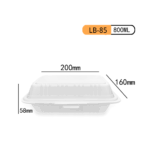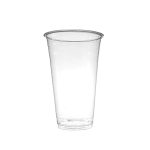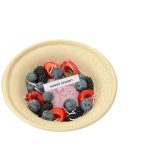✅ Introduction
Plastic waste is one of today’s most pressing environmental challenges. Businesses in the foodservice industry are under increasing pressure to adopt eco-friendly solutions due to global sustainability goals and local single-use plastic bans.
Enter corn starch packaging — a biodegradable, compostable alternative that meets both functional and environmental needs. This article explores what it is, how it works, key applications, and FAQs for businesses transitioning to greener options.
♻️ What Is Corn Starch Packaging?
Corn starch packaging is produced from natural starch extracted from corn kernels 🌽, blended with biodegradable components to create strong, heat-resistant containers and tableware. Unlike plastic, it composts within 3–6 months, leaving no toxic residue.
Key Features:
✅ 100% biodegradable and compostable
✅ Renewable raw material
✅ Heat-resistant (up to 110°C)
✅ Microwave-safe & food-contact certified
✅ Oil and moisture resistant
🍽️ Expanded Applications of Corn Starch Packaging
Corn starch packaging is now widely used across industries. Here’s where it’s making the biggest impact:
🍴 1. Catering & Large Events
Corporate conferences, weddings, outdoor festivals — event organizers now prefer corn starch plates, bowls, and cutlery to reduce plastic waste.
✔ Why it works: Elegant design, quick cleanup, eco-friendly branding.
👉 Explore Cornstarch Tableware

🥡 2. Restaurants & Take-Out Services
Restaurants and cafés are using corn starch hinged boxes and take-out containers for hot meals, pasta, and bakery products.
✔ Ideal for: Quick-service chains, fine dining with delivery, and fast-casual brands.
👉 Cornstarch Hinged Box | Take-Out Box

🚚 3. Food Delivery Platforms & Cloud Kitchens
With the surge in food delivery, platforms reward restaurants that adopt green packaging 🌱. Corn starch boxes provide leak resistance and maintain food quality during transit.
✈️ 4. Airlines & Rail Catering
Airlines and train services are replacing plastic trays and cutlery with corn starch bowls, plates, and utensils to meet sustainability goals without compromising food safety.
👉 Cornstarch Bowls

🏥 5. Hospitals, Schools & Institutions
Hospitals and schools require hygienic, disposable tableware that reduces contamination risks. Corn starch packaging offers a safe, eco-friendly alternative for high-volume food service.
🛒 6. Supermarkets & Retail Displays
Retailers and grocery stores use corn starch salad and light food boxes for ready-to-eat meals, salads, sushi, and fresh fruit.
👉 Cornstarch Salad Box

✅ Corn Starch vs Plastic vs Bagasse
| 🌍 Feature | Corn Starch 🌽 | Plastic 🛢️ | Bagasse 🌾 |
|---|---|---|---|
| Source | Corn-based | Petroleum-based | Sugarcane fiber |
| Biodegradable | Yes (3–6 months) | No | Yes (2–3 months) |
| Heat Resistance | ~110°C | ~120°C | ~100°C |
| Compostable | ✅ Yes | ❌ No | ✅ Yes |
❓ FAQ – Common Questions About Corn Starch Packaging
Q1: Can it be microwaved?
✅ Yes, safe for reheating food up to ~110°C. Avoid oven or direct flame.
Q2: How long does it take to degrade?
♻️ Around 3–6 months under industrial composting conditions.
Q3: Is it safe for food?
✅ Absolutely. Certified for FDA and EU food contact standards.
Q4: Does it work for oily foods?
✔ Yes, oil and water-resistant.
Q5: Can I recycle it?
❌ No, it is compostable (not recyclable). Dispose of in composting facilities.
🌍 About Xiamen Dashan
Xiamen Dashan is a trusted manufacturer of eco-friendly food packaging, offering corn starch tableware, hinged boxes, salad boxes, bowls, plates, and cutlery for global markets. All products meet international safety and sustainability standards.
✅ References
- European Bioplastics – https://www.european-bioplastics.org/bioplastics/
- UNEP – https://www.unep.org/plastic-pollution
- U.S. EPA – https://www.epa.gov/smm
- Food Packaging Forum – https://www.foodpackagingforum.org
- Bioplastics Magazine – https://www.bioplasticsmagazine.com/
- Packaging Insights – https://www.packaginginsights.com/
- ISO 18606 – https://www.iso.org/standard/63552.html
- Ellen MacArthur Foundation – https://ellenmacarthurfoundation.org/the-new-plastics-economy
Disclaimer & Copyright Notice
This article is created by the Dashan Packing editorial and research team.All information presented here is for educational and industry reference purposes only.Some data and standards cited in this article are sourced from publicly available materials,official regulatory documents, or third-party publications, which are properly credited where applicable.
All rights to third-party trademarks, images, and content belong to their respective owners.If any copyrighted material has been used inadvertently, please contact us at angel@chndashan.com.We respect intellectual property rights and will promptly remove or revise any material upon verification.





